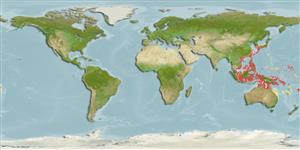>
Callionymiformes (Dragonets) >
Callionymidae (Dragonets)
Etymology: Synchiropus: Greek, syn, symphysis = grown together + Greek, cheir = hand + Greek, pous = foot (Ref. 45335).
Eponymy: Dr Jack Thomson Moyer (1929–2004) was an American marine biologist who lived for most of his life on Miyake-jima, Japan, where he became Director of the Tatsuo Tanaka Memorial Biological Station. [...] (Ref. 128868), visit book page.
More on authors: Zaiser & Fricke.
Environment: milieu / climate zone / depth range / distribution range
Ökologie
seewasser riff-verbunden; tiefenbereich 3 - 30 m (Ref. 12699), usually 3 - 30 m (Ref. 37816). Temperate
Western Pacific: widespread in the area. Replaced by Synchiropus stellatus in the Indian Ocean (Ref. 37816).
Size / Gewicht / Alter
Maturity: Lm ? range ? - ? cm
Max length : 7.5 cm TL Männchen/unbestimmt; (Ref. 48636)
Kurzbeschreibung
Bestimmungsschlüssel | Morphologie | Morphometrie
Rückenflossenstacheln (insgesamt) : 4; Rückenflossenweichstrahlen (insgesamt) : 8 - 10; Afterflossenstacheln: 0; Afterflossenweichstrahlen: 7 - 8; Wirbelzahl: 20 - 21.
Inhabits coastal reef slopes, usually on rubble and sand near large coral formations (Ref. 48636). Found in small loose groups and usually a large male dominates sections of reef (Ref. 48636). Small groups occur with one adult male (Ref. 90102).
Life cycle and mating behavior
Geschlechtsreife | Fortpflanzung | Ablaichen | Eier | Fecundity | Larven
Zaiser, M.J. and R. Fricke, 1985. Synchiropus moyeri, a new species of dragonet (Callionymidae) from Miyake-jima, Japan. Jap. J. Ichthyol. 31(4):389-397. (Ref. 12699)
IUCN Rote Liste Status (Ref. 130435: Version 2024-2)
Bedrohung für Menschen
Harmless
Nutzung durch Menschen
Tools
Zusatzinformationen
Download XML
Internet Quellen
Estimates based on models
Preferred temperature (Ref.
123201): 23 - 28.9, mean 27.7 °C (based on 440 cells).
Phylogenetic diversity index (Ref.
82804): PD
50 = 0.5000 [Uniqueness, from 0.5 = low to 2.0 = high].
Bayesian length-weight: a=0.00955 (0.00394 - 0.02313), b=2.96 (2.75 - 3.17), in cm total length, based on LWR estimates for this (Sub)family-body shape (Ref.
93245).
Trophic level (Ref.
69278): 3.3 ±0.4 se; based on size and trophs of closest relatives
Widerstandsfähigkeit (Ref.
120179): hoch, Verdopplung der Population dauert weniger als 15 Monate. (Preliminary K or Fecundity.).
Fishing Vulnerability (Ref.
59153): Low vulnerability (10 of 100).
Nutrients (Ref.
124155): Calcium = 55 [22, 115] mg/100g; Iron = 0.364 [0.191, 0.671] mg/100g; Protein = 19.1 [17.9, 20.2] %; Omega3 = 0.439 [0.210, 0.921] g/100g; Selenium = 5.45 [2.30, 13.29] μg/100g; VitaminA = 80.7 [18.9, 347.3] μg/100g; Zinc = 1.1 [0.7, 1.8] mg/100g (wet weight);
